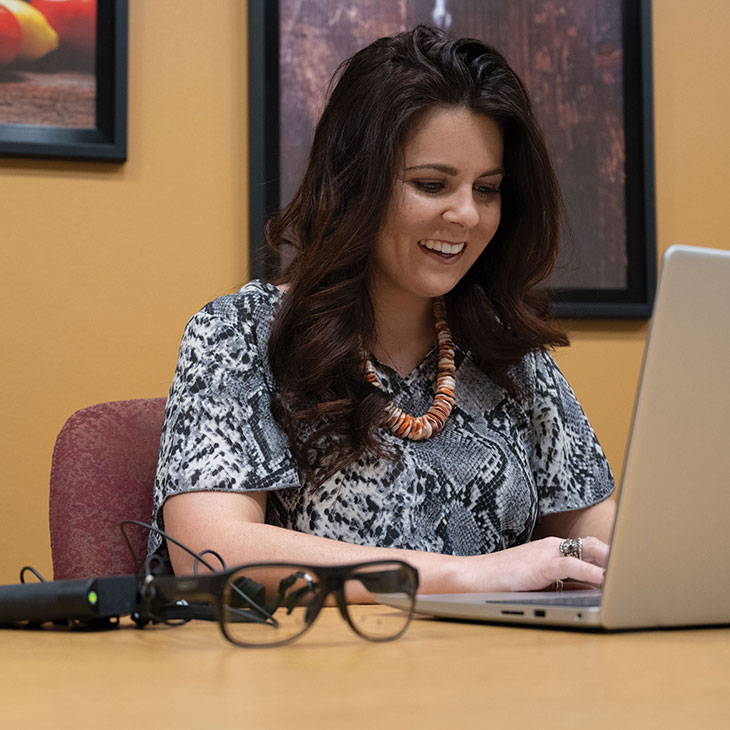
More Than Meets the Eye
Thursday, June 10, 2021
Media Contact: Samantha Siler | Communications and Marketing Manager | 405-744-2977 | samantha.siler@okstate.edu
A recent investment in eye-tracking glasses could allow the Oklahoma State University Robert M. Kerr Food and Agricultural Products Center and the agricultural communications program to “see” what you see.
The units partnered to invest in a pair of Tobii Pro Glasses 3. These specialized eyeglasses can track eye movement and the amount of time someone looks in a certain direction, said Megan Silveira, agricultural communications master’s student.
After an idea to purchase a pair of directional eyeglasses was discussed, a plan to invest in the technology was put into place, said Mandy Gross, former FAPC communications services manager.
“The faculty and staff in the agricultural education, communications and leadership department and the FAPC bought the glasses, a license for the technology, and a laptop that connects directly to those glasses,” Gross said.
Silveira was the first graduate student to use the equipment, getting help from Greg Clare, design, housing and merchandising associate professor, for the research and data analysis.
Clare has a two-dimensional, computer-mounted version of this eye-tracking technology and has partnered in other research studies.
“The Tobii X2-30 of Dr. Clare’s are different from the Tobii Pro Glasses 3 because the 2D technology doesn’t account for individual’s head movement or the direction they are looking,” Silveira said.
Once one calibrates the glasses to the participants’ eyes, the system tracks their head movement and where they specifically look through the glasses as they look at the screen, Silveira said.
“It’s set just to the screen, and it tracks the eye movement on the screen,” Silveira said. “The glasses basically examine the whole field of vision the viewer has. The Pro 3 glasses are 3D because we see in 3D, and that is what the glasses capture.”
The research Silveira conducted will help benefit FAPC with the evaluation of its newly redesigned website, Gross said.
“The first part of the research focuses on the usability of the FAPC website,” Silveira said. “The second part of research is testing these glasses for FAPC and getting the first experience with this type of technology.”
The research consisted of comparing data from the X2-30 system and other thesis research from OSU, Silveira said.
“I collected 15 sets of data with the computer-mounted device, and then another 15 with the eye-tracking glasses,” Silveira said. “I had participants look at the FAPC website on the same laptop, but data was collected with both of the different technologies.”
Volunteer participants had certain tasks to perform, such as finding specific information on the updated FAPC website, Gross said.
Silveira said having the opportunity to be the first to experience this technology opened her eyes and gave her new marketing knowledge.
“From an industry perspective, we want to give Oklahoma companies the best information about what the consumer is looking for, what caught the consumer’s attention, and why the consumer chose that product,” said Rodney Holcomb, agricultural economics professor who assists in FAPC.
Data from Silveira’s project shows researchers a rich data set and allows them to compare data from both the Tobii X2-30 and the Tobii Pro Glasses 3, Holcomb said.
“The technology can be used to examine consumers’ preferences,” Holcomb added.
In marketing, especially on a website, a lot of what you do revolves around finding the thing that attracts or catches the consumers’ attention, Holcomb said.

“Do consumers really care about pretty images and moving video background?” Holcomb asked. “Or are they looking for a link that’s not there because the design has been changed?”
Eye-tracking also can be used to examine consumers’ preferences in the food labeling aspect of the agricultural industry, which plays an important role in the world of marketing, Holcomb said.
When asking consumers if they would buy this product, the main concern is which specific product they would choose, Holcomb said.
“With these eye-tracking glasses, we can send someone to the store and let them buy whatever they would buy normally while we see what they are looking at,” Holcomb said.
“Take produce, for example,” Holcomb said. “The consumer may look at where the product is grown or visual appeal of the products.”
The glasses are being used to obtain research about what consumers care about, Holcomb said. They help to discern if consumers spend their time contemplating price, where the product was grown or how the product looks, he added.
“In addition, researchers get a better idea of what factors really impact consumers’ buying, as opposed to what they say impacts their buying,” Holcomb said. “Consumers don’t realize what unconscious factors impact their buying decisions.”
In the future, FAPC staff plans to partner with different agricultural industries to determine what food la-bels attract the consumer’s attention, Gross said.
“Research with these glasses will prove to be beneficial in the agricultural field and marketing in general,” Silveira said. “I am excited to see the impact they will have.”
Story By: Tianna Kozuszek | Cowboy Journal
